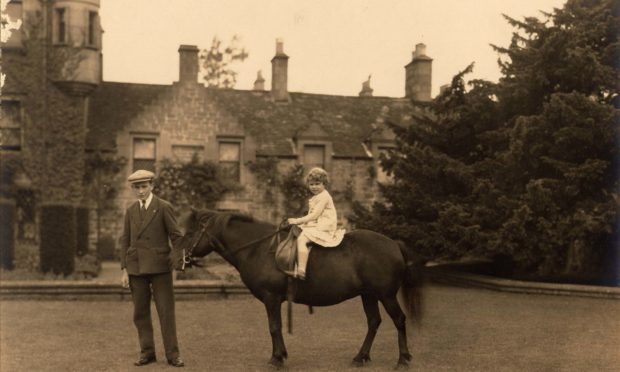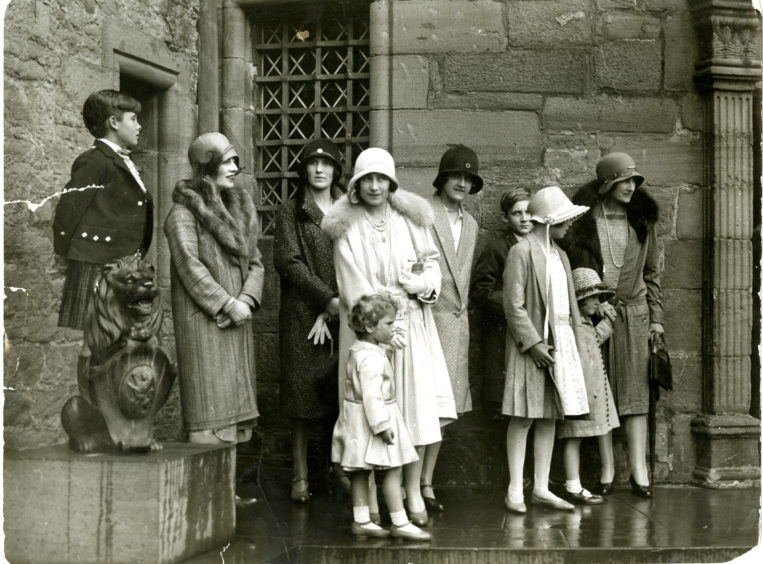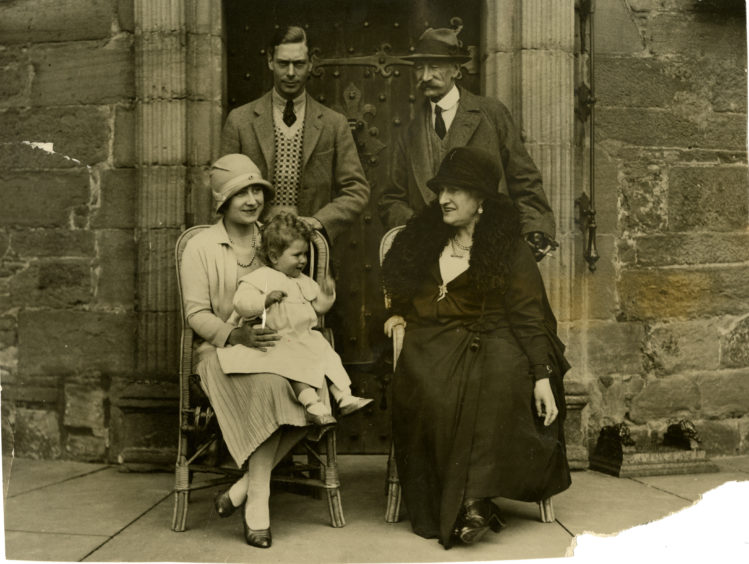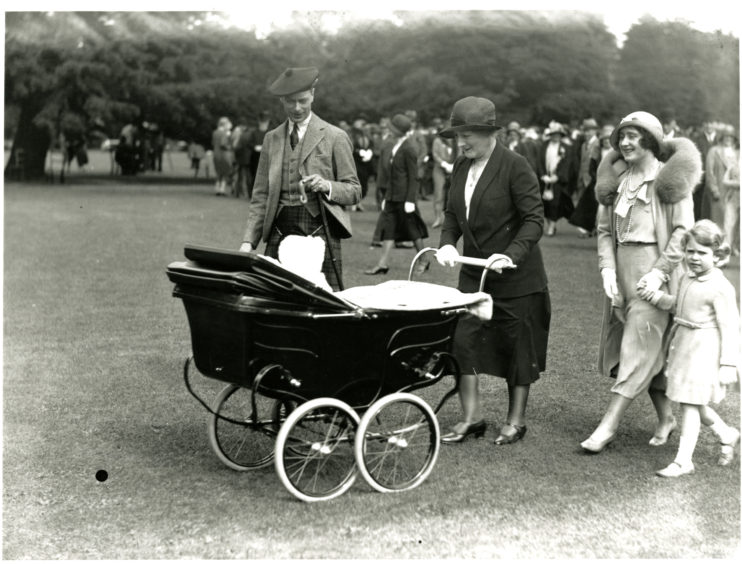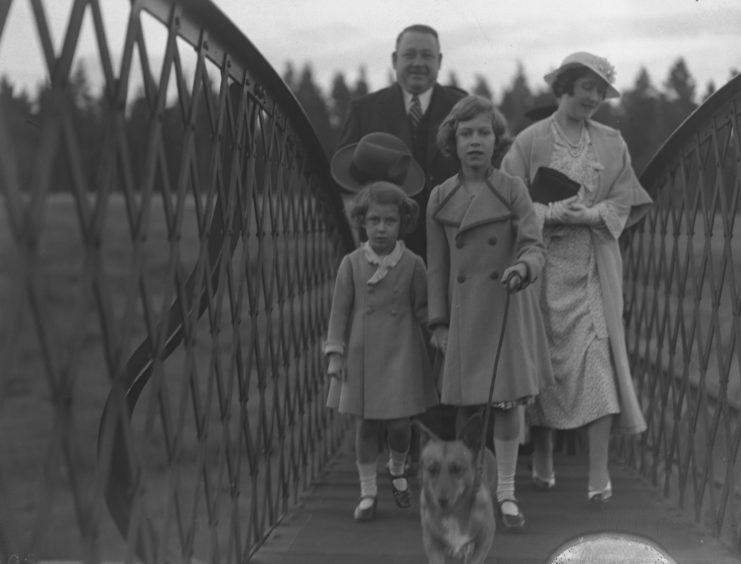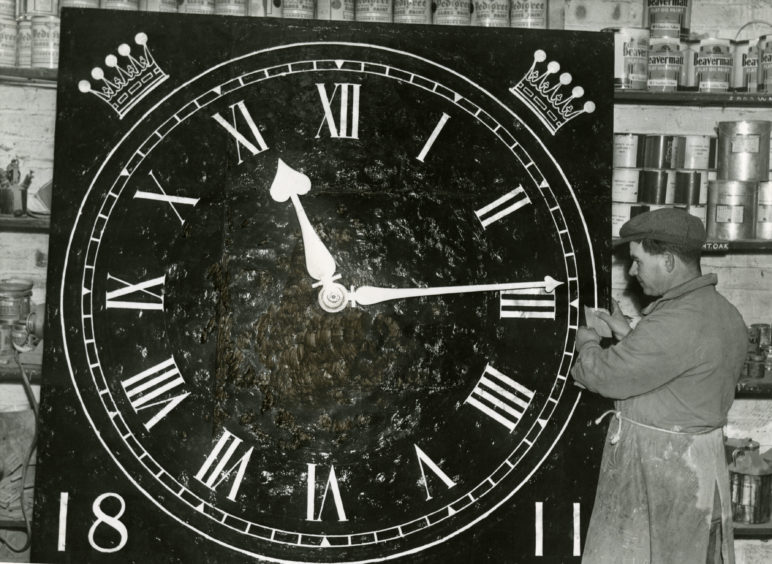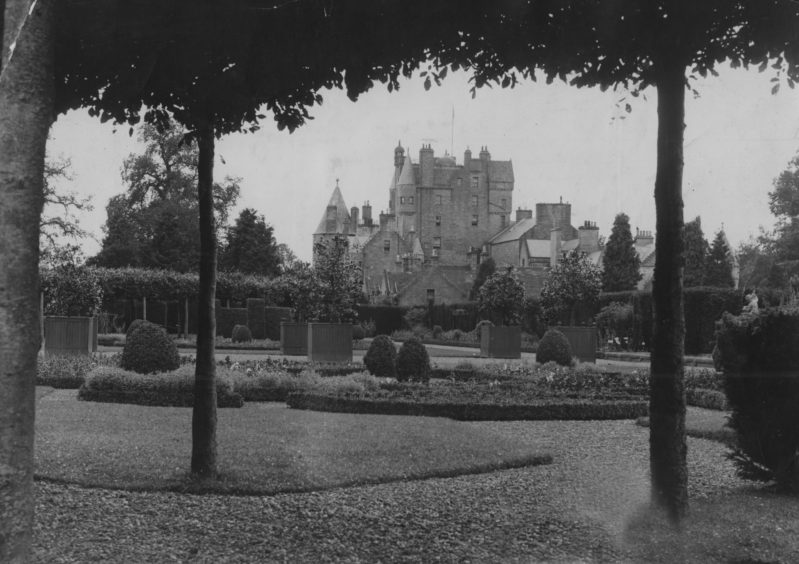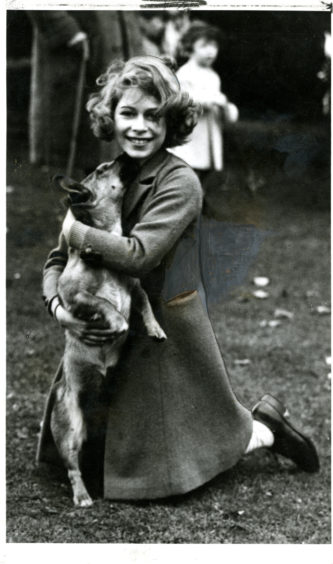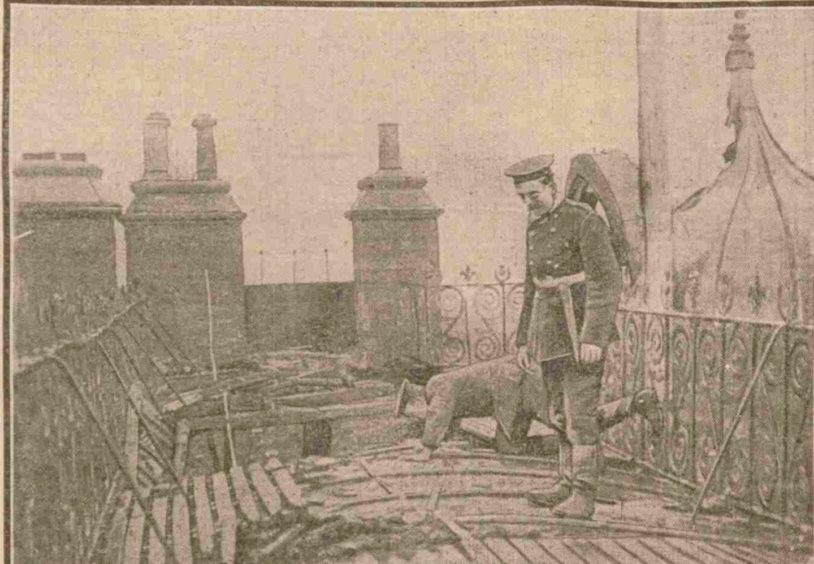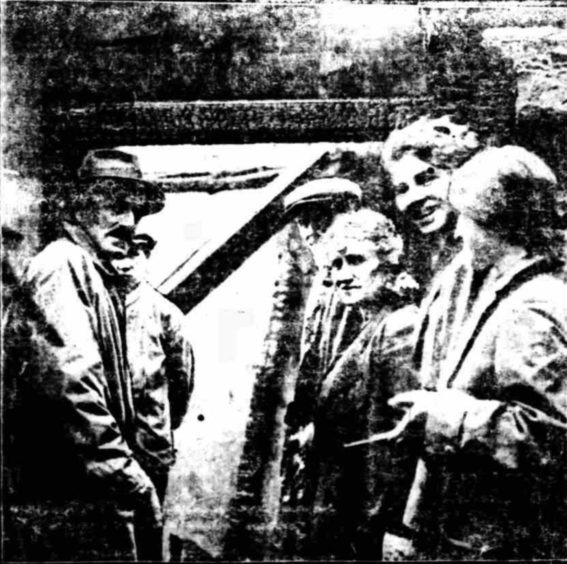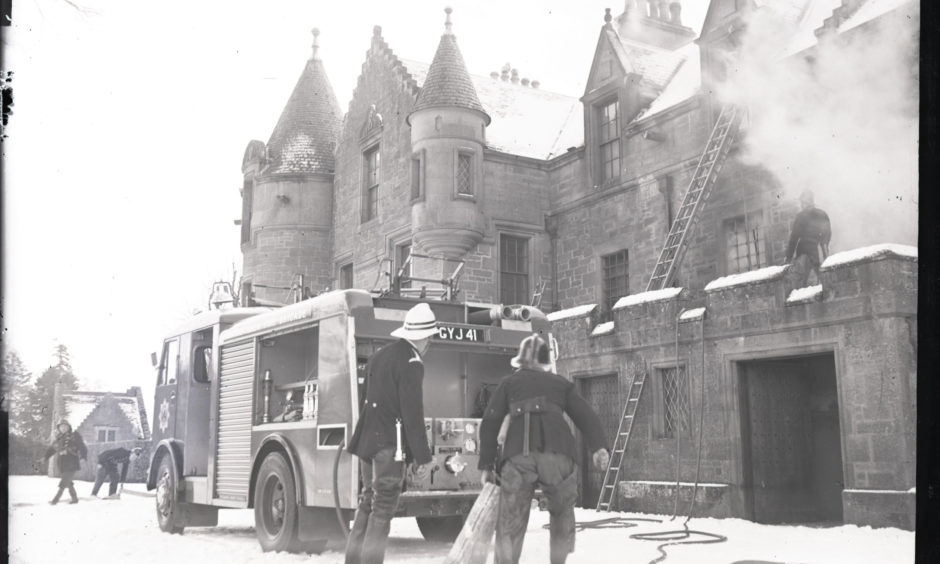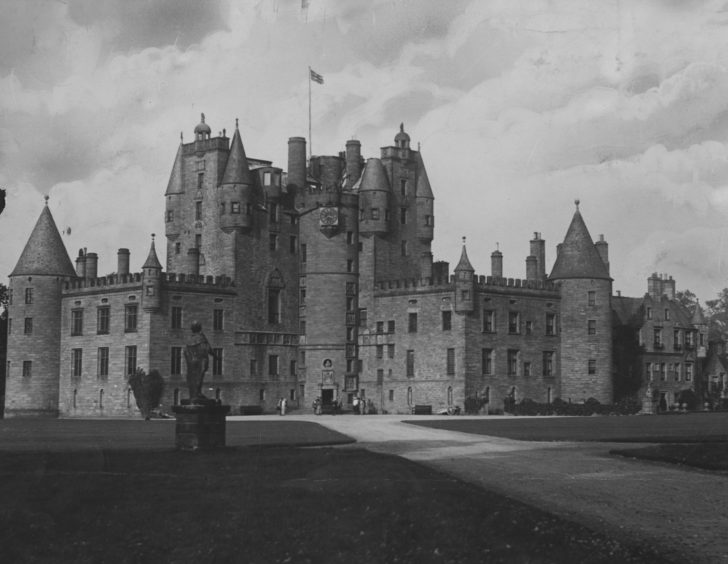Glamis Castle opened to the public in the summer of 1950 but could have burned to the ground 34 years earlier had it not been for a royal intervention. Gayle Ritchie looks back at the grand opening and how the Queen Mum was instrumental in saving the castle from destruction…
With its majestic array of turrets, towers and battlements, Glamis Castle is the epitome of a fairytale palace.
Steeped in history, as well as a good deal of myth and legend, the castle was the childhood home of the Queen Mother and the birthplace of Princess Margaret.
It also served as inspiration for Shakespeare’s famous Scottish play Macbeth.
Set in the lush Angus countryside, the castle is the ancestral seat to the Earls of Strathmore and Kinghorne.
The building itself dates back to 1400, but the area where the majestic property now sits was witness to hundreds of years of royal history prior to its construction.
In 1034, King Malcolm II was murdered on the site of the current castle, and as the decades have passed, Glamis has seen many turbulent events unfolding.
In 1537, Glamis was forfeited to the Crown and occupied by James V until his death in 1542.
And if you tour the castle today, you’ll see the room where Mary, Queen of Scots stayed when she visited with her entourage in 1562.
Fast forward a few hundred years, and the 14th Earl and his wife Countess Cecilia lived at Glamis along with their daughter, Lady Elizabeth Bowes-Lyon, the future queen consort to King George VI.
Born on August 4 1900, mystery surrounds the exact birthplace of Lady Elizabeth (the future Queen Mother), although it is known that it was not at Glamis Castle, as is often assumed.
It was only when Elizabeth was four and her grandfather, the 13th Earl, died, that her father inherited the Glamis estate.
Lady Elizabeth lived an idyllic childhood at Glamis and later helped with the war effort when the castle was converted into a convalescent home for wounded soldiers during the First World War.
Elizabeth personally cared for the soldiers, winning them over with her kindness.
On April 21 1926, Lady Elizabeth gave birth to a baby girl also named Elizabeth – the girl who would become our future Queen.
Four years later, in 1930, Lady Elizabeth (who became known as Queen Mother when her daughter became Queen at the age of 25) returned to Glamis Castle to give birth to Princess Margaret on August 21.
The two young princesses would visit Glamis for summer holidays, and to this day, you can view letters they wrote to their grandparents in the exhibition room at the castle.
The castle is still very much a part of the Bowes-Lyon family’s legacy, and the current Earl of Strathmore and Kinghorne – Simon Bowes-Lyon, a cousin of The Queen – lives on the estate.
Opening day in 1950
Although the gardens and grounds of Glamis Castle had been open to the public on occasion since the 1930s, it wasn’t until July 1950 that the castle opened its doors to visitors.
The reason behind this? The Earl of Strathmore, the Queen’s nephew, said heavy taxation and the death duties of his father and grandfather within five years were the deciding factors.
The public opening was to be on a small scale at first – opening just twice a week – because of a lack of staff.
The Press and Journal reported on July 27 1950 that visitors queued in abundance to enter the castle for the first time.
The report stated: “Timothy Patrick Bowes-Lyon, 32-year-old Earl of Strathmore and nephew to the Queen, stood on the lawns of Glamis Castle yesterday, pointed to a long queue of sightseers and said: ‘I am really grateful to these people. The small fee they pay for admittance will be spent on maintenance.’”
More than 1,000 people paid for admittance. For two shillings – just one shilling for children – tourists and holidaymakers were taken on 30-minute tours of the ancient building.
Miss Margaret Wald conducted the first party of visitors of which an unnamed P&J reporter was a member.
“First stop after climbing the main stairway was the armoury, where a coat worn by ‘Bonnie Dundee’ – Graham of Claverhouse – and boots worn by Charles I. were the main items of interest,” wrote the correspondent.
“The crowd chatted excitedly when Miss Wald led them into a small chamber and pointed to the spot where Lady Macbeth stabbed Duncan, King of the Scots.
“But a quiet hush fell over the gathering as they were gathered into the pale gold and white bed chamber used by the Queen on her visits to Glamis.”
Other highlights of the first tour included Her Majesty’s sitting room. “From the walls hang rich tapestries and the centre-piece of the room is a 17th century cupboard carved from a solid block of wood,” said the report.
Glamis Castle fire
During the First World War, the future Queen Mother, Elizabeth Bowes-Lyon, helped to look after injured soldiers, when Glamis Castle was used as a military hospital.
On September 16 1916 – a Saturday – nine of the soldiers had gone to watch a film at the pictures in Forfar, while 16-year-old Elizabeth’s father and younger brother David were out shooting on the estate.
A few soldiers remained at the castle with Elizabeth including Sergeant Cowie, whom she described as “remarkably good looking…very quiet and Scotch and huge”.
It was he who smelled smoke and discovered a fire in a room under the castle roof.
As he ran to raise the alarm, Elizabeth took charge and rang the fire brigades at both Forfar and Dundee.
In the meantime she, the soldiers and all the maids were reported to have “rushed up and handed buckets like old Billy-oh. The more water the more smoke, we absolutely could not find the fire”.
Villagers from Glamis arrived to help but still the fire spread until – as Elizabeth wrote in a letter: “the little flames were sort of creeping through the roofs…it was too awful.”
The Forfar team arrived but, according to Elizabeth, “were absolutely no use” as they only had a hand pump which was unable to get water 90ft up the tower, which was the seat of the fire.
Fortunately, the Dundee firefighters arrived after 26 minutes and were able to spray water across the rooftops with their more powerful engines.
Gradually, the fire was brought under control but then a new crisis developed.
The cold water storage tank in the roof burst with the heat and its contents cascaded down, along with the water from the firefighters’ hoses.
“The little flames were sort of creeping through the roofs…it was too awful.”
Elizabeth immediately saw the danger to the contents of the castle and arranged for a team to brush the water down the tower steps to the ground floor, away from the main family rooms.
At the same time, she directed around 30 villagers to stand in line to remove all the pictures, valuable objects and furniture at risk onto the lawn and later moved them to safe, dry rooms.
When night fell, she searched for candles so she could continue the rescue effort as best she could.
The 1683 tapestry created by the 3rd Countess of Strathmore was among the treasures saved.
Another item rescued was the door leading to the attic. Its scorch marks are still visible.
“It was too dreadful…we thought the whole place would be burned,” said Elizabeth at the time. It was indeed a close call.
Next day, the wind strengthened, and Captain Weir, the chief of the Dundee Fire Brigade, told Elizabeth that nothing would have saved the castle had the wind been as strong the previous day.
Ultimately, only the rooms at the very top of the castle were destroyed by fire, but the water damage was extensive.
Elizabeth’s crucial role was clear to all and the Dundee Courier reported that she was “a veritable heroine in the salvage work she performed even within the fire zone”.
In 1918 the armistice signalled the end of the war and the end of an era.
Once the last soldier had left Glamis in 1919, Elizabeth was launched into the high society of the day at her coming out party.
Another blaze
Decades later, fire broke out again, this time in February 1960. Six apartments above stable accommodation in the unoccupied north-east wing were damaged.
A report at the time said: “No flames were visible but firemen wore breathing apparatus to get through the smoke.”
A castle tour
Every room within Glamis Castle has its own story and the evolution of the castle and legendary tales are brought to life by expert tour guides.
You will even see the tiny chairs that the Princess Elizabeth and Margaret used during their childhood visits.
Rooms to visit include the billiard room, chapel. crypt, dining room, drawing room, Duncan’s Hall. King Malcolm’s Room and Royal Apartments.
Family portraits abound and visitors will find carved lions, in honour of the family name Bowes-Lyon, at every turn.
Steeped in history, Glamis Castle truly is a national treasure.
